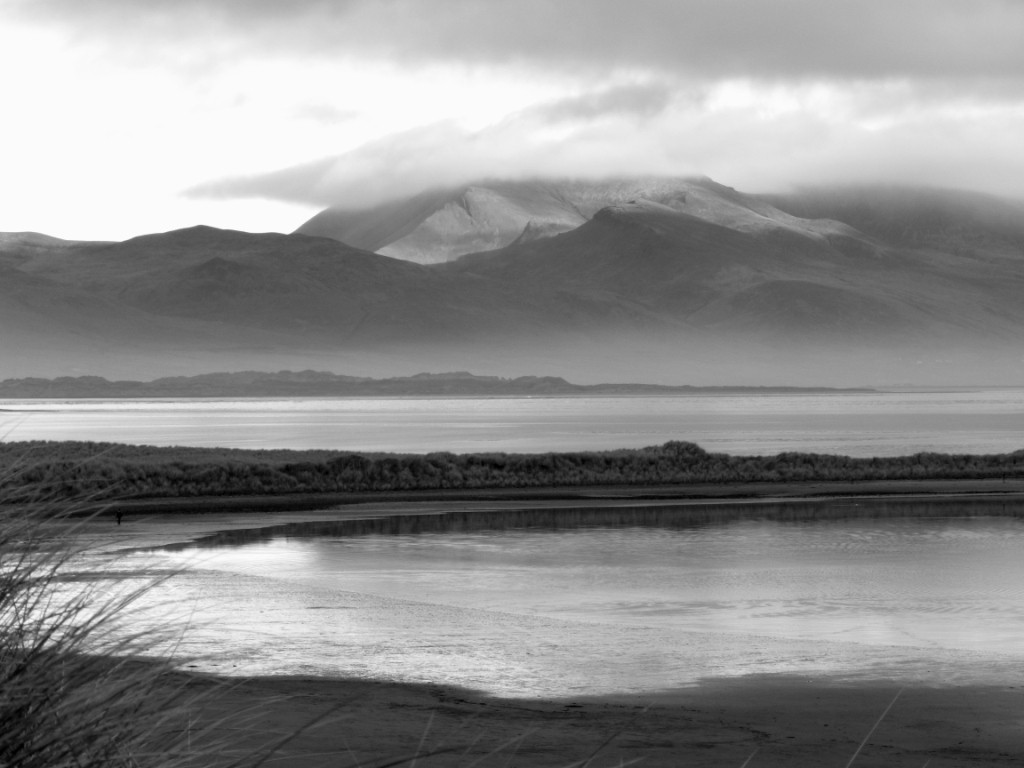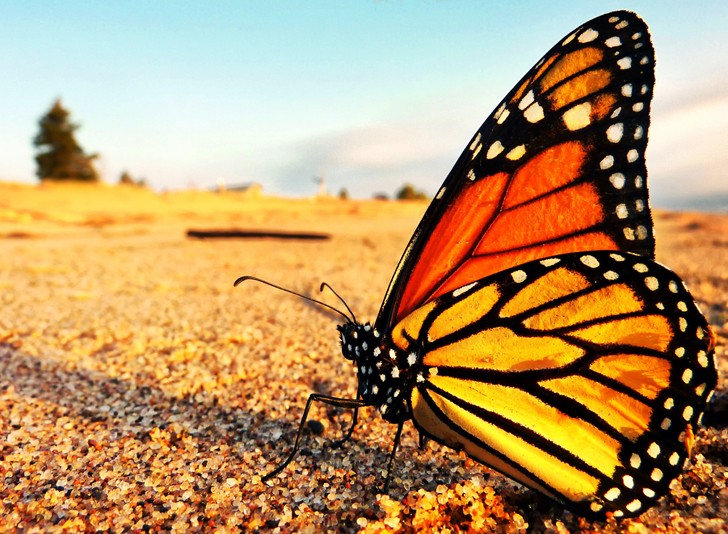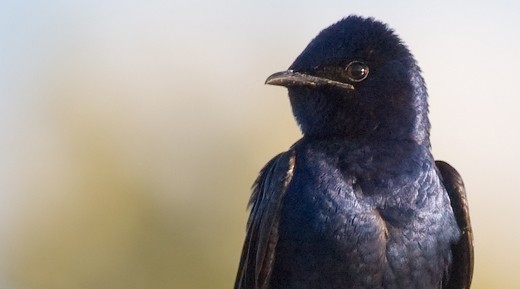By Sean Fagan

Dune systems are often overlooked as regards bushcraft camping, which is a shame - they are often fantastic, beautiful locations with a wealth of unusual flora and fauna. In fore and mid-ground of photo - Glenbeigh dune system - a beautiful, wide, sandy peninsula covered with marram grass. In background, the magnificent Dingle peninsula (Photo: Sean Fagan, southwest Ireland).
.
.
Even though it was quite a few years ago, I still have vivid memories of a camping trip I took on a dune system in New Jersey, USA.
.
It was late august.
And the days were long, sunny and glorious.
.
I love dunes.
Sea meets sand with vast, open skies above…
...what’s not to love?
.Is it any wonder that the writer Henry Beston wrote, what is widely considered his best outdoor book - the Outermost House, while living on a sandy, coastal peninsula for a year?
This following quote of his originates from his time living near the sea, while writing The Outermost House...
“The three great elemental sounds in nature are the sound of rain, the sound of wind in a primeval wood, and the sound of outer ocean on a beach. I have heard them all, and of the three elemental voices, that of ocean is the most awesome, beautiful and varied.”
.
As stated already, I camped on those New Jersey dunes quite a few years ago. Unfortunately, I didn't bring a camera so I've no photos of the trip.
But I've included some recent photos of my own and from elsewhere that are relevant to this article.
However, this article is mostly a descriptive, mood piece - with a dash of humour.
My time on that sandy stretch of New Jersey coastline shines brightly in my memory like the bright sands of those dunes.
The great and varied moods of that place - so near the vastness of the sea and sky - is a memory that will forever resonate within me.
.
What is Bushcraft for Me?
.
For myself, bushcraft and adventure is primarily a means of getting closer to nature. With bushcraft skills, I can comfortably live in wild, rugged places that are often remote and overlooked.
It's a reoccurring theme of mine...that bushcraft and adventure is a great vehicle for exposing ourselves to the inspiring, rugged grandeur of wild places.
I hope that this feeling is conveyed in the following article and that you will, the reader, take that extra step in losing yourself to the enduring rhythms of nature.
On a more prosaic note, exploring wild places is also good for our physical and mental health.
.
One of the Great Trails of the World...
.
The whole eastern coastline of North America is one of the great natural migration routes of the world.
A great variety of animal species have used this route for many millennia with various turtle, fish, whale and bird species using it as a migration route.
Every spring, many of these migratory species head north along the coast to disperse among the more northerly latitudes of the the earth.
Then, with the cool of autumn arriving – the same migratory species trail southwards along the same coastal corridor from which they arrived last spring.
Some species trickle through, while others pass through in great congregations.
.
The Great Migration of a Gentle Traveller...
.
Every day while I was on those dunes – a small but persistent number of stunning, ember-orange monarch butterflies floated through the briny air in a southward direction.
They seemed to pass over some invisible narrow corridor over the flat, tidal sand that spanned between the sea and the start of the dunes which was about 100 metres wide.
Only rarely did I witness a butterfly passing directly over the dunes or the sea.
.

A resting monarch butterfly (Danaus plexippus). Monarch caterpillars feed upon the milkweed plant, which is poisonous. As a result the butterfly is also poisonous and advertises this fact to any potential predators with its stunningly bright colours (Photo: Wikimedia commons images).
.
Monarchs are a large butterfly species, and fly with a buoyant, slow flight pattern - making them appear all the more fragile in the largeness of the world that surrounds them.
To witness in the flesh the mass desire of an insect species attempting such an epic 2,000 - 3,000 mile journey from their summer grounds in North America to their wintering grounds in central Mexico was to experience a truly gritty marvel of life.
Such immense desire contained within something so small, is to my mind, truly epic.
Fair enough, their desire to travel so far and arduously is indelibly programmed within their DNA - through the slow, eon-plod of evolution influencing countless generations of butterflies.
But it's still a miraculous thing to witness such beautiful complexity of form and raw desire contained within something so small, so seemingly fragile - yet resilient, even epic.
.
Mass Exodus
.
One day on the dunes really stood out.
It all started with a sound.
An ominous droning sound reverberated heavily over the bright sands of the dunes.
The skies above literally started to darken as the droning intensified.
Slowly they came but come they did - a huge flock of migrating purple martins.
.

The purple martin (Porgne subis) is a stunning bird. The male of the species, as in photo, is particularly striking - with its iridescent, glossy-purple plumage (Photo: Wikimedia commons images).
..
There must have been literally thousands in this singularly huge, heaving mass.
Occasionally, many of them would abruptly descend on berry-laden bushes – greedily devouring all berries in sight.
This was all the more remarkable when you consider that purple martins are predominantly insect eaters.
They were simply ravenous.
The sheer effort of migrating and the occasional paucity of insects en route may have driven them to devour an alternate food source such as berries.
As I watched, enthralled – an idea popped into my head.
I walked up to some bushes that still had berries.
Sure enough, the martins quickly descended on the bushes – and even though I stood right beside them, they would still greedily gorge themselves – so profound was their hunger.
I even touched one of them while it fed. It simply did not care. Fear replaced by near starvation.
Then, as suddenly as they landed they were gone - seamlessly re-joining the main flock.
It’s rare to come across so much life in one place.
And it’s hard to describe what it is like to be within such a dense, teeming multitude. It’s pretty amazing.
.
Like a dark cloud of locusts crossing a desert, they moved up and down the dunes for about an hour.
Then they were gone, returning the dunes to its more familiar sounds of swaying marram grass, hushing waves, the odd seabird call...
.
An Encounter with a Bandit
.
Not all my wildlife encounters were so benign and inspiring.
Some were comical.
One day, after a long hike across the dunes, I was making my way back to camp at sunset.
I was beat tired – the heat, sun and the effort of walking over steep sandy dunes took their accumulative toll.
But it was a great day and it was hard to stop walking.
But I was eager for my bed.
Just as I approached my tent – I glanced to my left where my food stash was suspended in a bag about 6 feet off the ground in a large shrub (I did this to avoid the attention of scavenging animals such as foxes).
.
“What the hell!” I blurted out.
The striking, striped face of raccoon looked right back at me, equally startled.
Without a word of a lie…the right paw of the racoon was in my bag, about to tuck in.
I literally caught it, red-handed, stealing my food.
.
“Get the hell away from my food!” I shouted without thinking.
The raccoon quickly descended and believe it or not – lingered around nearby, hidden by the darkness and foliage.
I grabbed my food bag and made my way to my tent…more than a little disgruntled, and more shaken than I would have liked to admit (raccoons have a reputation for being fierce fighters).
To unwind, I read a book for a while.
It wasn't long before I started to nod off.
.
It was a gentle, tentative sound against the surface of my tent that woke me up.
Like a soft, scratching sound.
.I instantly knew it was that damn raccoon.
.“Get lost” I said, sheepishly, from my sleeping bag.
The scratching continued.
“Get lost, I mean it!” I exclaimed, a good bit louder – trying with much bluster to sound more authoritative.
.
Unbelievably, the scratching continued.
“Would you ever f**k off!” I shouted – mostly angry but a little frightened at the persistence of this determined mammal.
Silence.
.Then, and I couldn’t believe what I heard, the raccoon made a few snorting sounds, and noisily walked off.
I swear I could've heard a derisory tone to those parting snorts.
.

Front track of a raccoon. Note the distinctively long, five digit outline. It's easy to see from this track, that raccoons are quite dexterous and have rightfully earned the reputation as nimble-digit opportunists (Photo: Sean Fagan, Maine, USA).
.
.
Blissful Days
.
I stayed on those dunes for 9 days.
Besides raccoon-gate, my time there was amazing.
That's the way it goes with camping - most trips are great, some mediocre, with a few being poor.
But some are pretty damn close to perfection.
My time on those dunes was close to perfection. I was very happy there.
.Tracking, hiking, some bird-watching, swimming, watching the endless, trailing monarch butterflies on the wing - was my daily routine.
Each evening a pattern would slowly emerge...
A red fox would briefly appear, disappear and reappear throughout the dunes, like an elusive, red-flamed ghost.
As the light finally faded into oblivion, the local gray catbirds would offer their staccato dusk chorus to the world before quietly turning in for the night.
.
Then the stars would emerge as a dark silence settled over the dunes.
.A exalted, deep, wide silence that seemed to envelop the world...occasionally interrupted by the gentle, hushing rhythm of waves on sand.
.
A great, great time.
And bushcraft helped me have this adventure - one I'll never forget.
.
.
.
Related articles on this website:
.
*Check us out on Instagram, Twitter & Facebook for more outdoor-related topics..
Related material:- The Purple Martin (from the wonderful Cornell Lab of Ornithology)
- The Monarch Butterfly (includes a great video, "It's a small animal that travels a lot")
- The Gray Catbird
- The Raccoon "Raccoons are highly intelligent and curious creatures, but they can also be a nuisance..." as I know all too well : )
- How Sand Dunes Work
- Henry Beston
.
Resources:- Cornell Lab of Ornithology home course in Bird Biology (a great course, and very reasonably priced. This course has been running for 40 years!).
.
Brief video about the ongoing crisis facing monarch butterflies (including how people can help).
Recent Comments